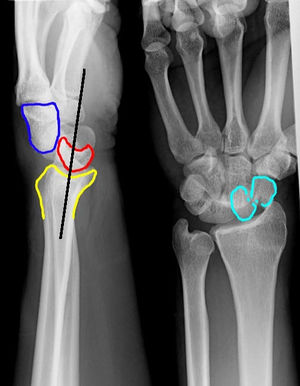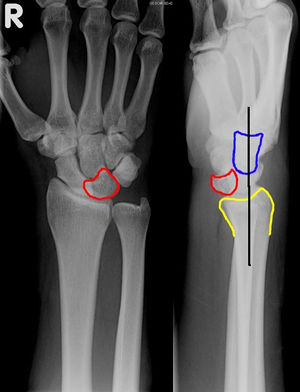We need you! Join our contributor community and become a WikEM editor through our open and transparent promotion process.
Perilunate and lunate dislocations
From WikEM
Contents
Background
- Occur via high-energy FOOSH injury (fall from height, MVC)
- Perilunate Dislocation = Lunate stays in place, capitate is displaced
- Lunate Dislocation = Capitate stays in place, lunate is displaced
- Must rule-out median nerve injury
- Must rule out carpal bone fractures
Clinical Features
- Perilunate dislocation: dorsal swelling with palpable mass
- Lunate dislocation: volar swelling with palpable mass
Evaluation
Perilunate Dislocation
- Lateral view
- Capitate displaced dorsal to lunate
- Lunate retains its normal contact with radius
- PA view
- Capitolunate joint space is obliterated as the bones overlap one another
Lunate Dislocation
- Lateral view
- Lunate is pushed off the radius into the palm ("spilled teacup" sign)
- PA view
- Lunate has triangular shape ("piece-of-pie sign")
Differential Diagnosis
Carpal Dislocations
- Scapholunate dissociation
- Perilunate and lunate dislocations
Carpal fractures
- Scaphoid fracture
- Triquetrum fracture
- Lunate fracture
- Trapezium fracture
- Pisiform fracture
- Hamate fracture
- Capitate fracture
- Trapezoid fracture
Treatment
- Closed reduction and long-arm splint
- Likely requires emergent ortho consultation (very difficult to reduce with high incidence of median nerve compression)
See Also
References
- Emergency Orthopedics, The Extremeties
- Radiopaedia.org


